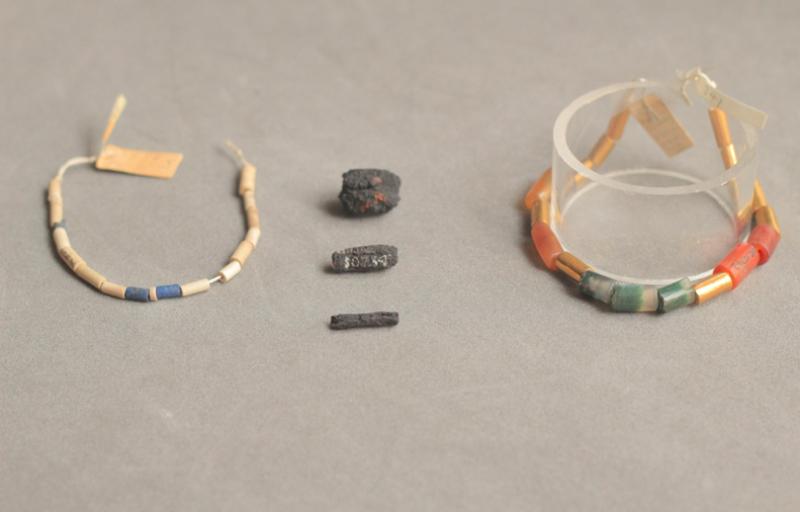 [Image: Ancient Egyptian jewelry made from meteorites; photo courtesy of UCL Petrie Museum/Rob Eagle].
[Image: Ancient Egyptian jewelry made from meteorites; photo courtesy of UCL Petrie Museum/Rob Eagle].
X-ray analysis has found that “ancient Egyptian iron beads held at the UCL Petrie Museum were hammered from pieces of meteorites, rather than iron ore,” Science Daily reports. “The objects, which trace their origins to outer space, also predate the emergence of iron smelting by two millennia.”
By scanning the beads with beam of neutrons and gamma-rays, the team were able to reveal the unique texture and also high concentration of nickel, cobalt, phosphorus and germanium—which is only found in trace amounts in iron derived from ore—that is characteristics of meteoric iron, without having to attempt invasive analysis which could potentially damage these rare objects.
The “meteoric ore”—that, presumably, at least in some instances, had been seen falling from the sky like heavenly precipitation—was hammered and rolled into pieces of ceremonial jewelry to be worn like gifts from the sky.
This brings to mind the famed “space buddha” of last year: “An ancient Buddhist statue which was first recovered by a Nazi expedition in 1938 has been analyzed by a team of scientists,” Science Daily wrote last summer, revealing “that the priceless statue was carved from an ataxite, a very rare class of iron meteorites.”
 [Image: Space buddha! Photo by Dr. Elmar Buchner, via Science Daily].
[Image: Space buddha! Photo by Dr. Elmar Buchner, via Science Daily].
Fabricating objects from chunks of metal that have fallen from space—or humans artifacts emerging from astral wreckage scattered across the surface of the planet—is a pretty compelling design scenario, I have to say, and to read that some of humanity’s “earliest known iron artifacts come from outer space” only adds a new, strange gleam to an already fascinating civilization.
However, we can only speculate what it might like in several generations’ time if industrial super-projects like offworld mining and post-planetary extraction do, in fact, take off—if geochemical reserves on the moon, for instance, are harvested for use in terrestrial power stations, batteries, and other pieces of electrical infrastructure—to know that, in that power plant humming away quietly in the forest north of New York City, surrounded by old trees and cliffs on the riverside, pieces of the moon and captured asteroids are burning, becoming fuel and light for our cities. Our devices will glow with the light of alien worlds, rocks alchemically scorched and purified in huge ovens run by ConEd.
And, in 5,000 years, archaeologists will uncover the crumbled dust of other planets in our factories, still glistening amongst the ruins in which they burned, perhaps wondering what religious connotation the power system played for us, this shining network where we ritually incinerated the heavens, computational clouds run with unearthly fuels that, like the Egyptian jewelry this post started with, can “trace their origins to outer space.”

I'm reminded of artist Katie Paterson's project to cast, melt, and recast a meteorite as a model of itself, before sending it back out into space with the help of the European Space Agency. Perhaps future civilizations (either here or elsewhere), will witness it fall and refashion it yet again, marveling at its anomalous structure (no Widmanstätten patterns).
Cool – I'd forgotten about that. Thanks, Nicky!
The Sacred Stone of Cybele in Ancient Rome was supposed to be a meteorite too, but seems to have vanished at the end of antiquity. Perhaps it was melted down and recycled with tiny fragments now scattered across the world, in toasters and cars…
It seems to me that it would be more correct to state that a German rather than a "Nazi" expedition discovered this statue in 1938. Such an important roughly datable artifact indicates the importance that has been attached to meteorite metals.
Anonymous, if Wikipedia is anything to go by—the source it cites is in German, which I don't read, but you could check—the expedition was personally funded by Heinrich Himmler and the SS, including for reasons of finding and developing seeds that would be used to re-plant Europe after the war (Schäfer was a zoologist). That sounds like a Nazi expedition to me, unless you have some other reason for objecting.